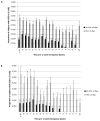Longitudinal pattern of depressive symptoms around natural menopause
- PMID: 24227182
- PMCID: PMC4576824
- DOI: 10.1001/jamapsychiatry.2013.2819
Longitudinal pattern of depressive symptoms around natural menopause
Abstract
Importance: An increased risk of depressive symptoms has been associated with the transition to menopause, but the risk of depressive symptoms in the early postmenopausal years has not been well characterized.
Objectives: To identify within-woman changes in depressive symptoms during a 14-year period around menopause, determine associations of a history of depression with the pattern of depressive symptoms, and evaluate the rate of change in reproductive hormones as predictors of depressive symptoms following menopause.
Design, setting, and participants: A randomly identified, population-based sample in Philadelphia County, Pennsylvania, of 203 late-reproductive-age women who were premenopausal at baseline and reached natural menopause.
Main outcomes and measures: Center for Epidemiologic Studies Depression Scale.
Results: The prevalence of high scores on the Center for Epidemiologic Studies Depression Scale decreased from 10 years before to 8 years after the final menstrual period (FMP), with a decrease of approximately 15% of baseline per year (odds ratio, 0.85; 95% CI, 0.81-0.89; P < .001). Relative to the FMP, the risk of depressive symptoms was higher in the years before and lower in the years after the FMP. Among women with a history of depression, the likelihood of depressive symptoms was more than 13 times greater overall and 8 times greater after menopause compared with women with no depression history. Among women who first experienced depressive symptoms approaching menopause, the risk of depressive symptoms declined after the FMP, with a significantly lower risk the second year after menopause. The risk of depressive symptoms after menopause decreased by 35% for each unit (SD) increase before the FMP in the log rate of change of follicle-stimulating hormone (odds ratio, 0.65; 95% CI, 0.46-0.91; P = .01).
Conclusions and relevance: The FMP was pivotal in the overall pattern of decreasing depressive symptoms in midlife women, with higher risk before and lower risk after the FMP. A history of depression strongly increased the risk both before and after menopause. Women who had no history of depression before the menopause transition had a low risk of depressive symptoms 2 or more years after the FMP.
Conflict of interest statement
Dr. Freeman reported research support (issued to the University of Pennsylvania) from Forest Laboratories, Inc. Bionovo, Inc, and Xanodyne Pharmaceuticals, Inc.
Dr. Sammel reported honoraria for lectures from the University of Rochester and Arcadia College; travel and meeting expenses from the University of Alabama Birmingham and The North American Menopause Society; consultant for Swiss Precision Diagnostics; statistical editor for the American Journal of Obstetrics and Gynecology.
Mr. Boorman reported no conflicts.
Dr. Zhang reported no conflicts. Dr. Zhang’s work on this project was during her doctoral training at the University of Pennsylvania.
Figures

References
-
- Freeman EW, Sammel MD, Liu L, Gracia CR, Nelson DB, Hollander L. Hormones and menopausal status as predictors of depression in women in transition to menopause. Arch Gen Psychiatry. 2004;61(1):62–70. - PubMed
-
- Cohen LS, Soares CN, Vitonis AF, Otto MW, Harlow BL. Risk for new onset of depression during the menopausal transition: the Harvard study of moods and cycles. Arch Gen Psychiatry. 2006;63(4):385–390. - PubMed
-
- Freeman EW, Sammel MD, Lin H, Nelson DB. Associations of hormones and menopausal status with depressed mood in women with no history of depression. Arch Gen Psychiatry. 2006;63(4):375–382. - PubMed
Publication types
MeSH terms
Substances
Grants and funding
LinkOut - more resources
Full Text Sources
Other Literature Sources
Medical

